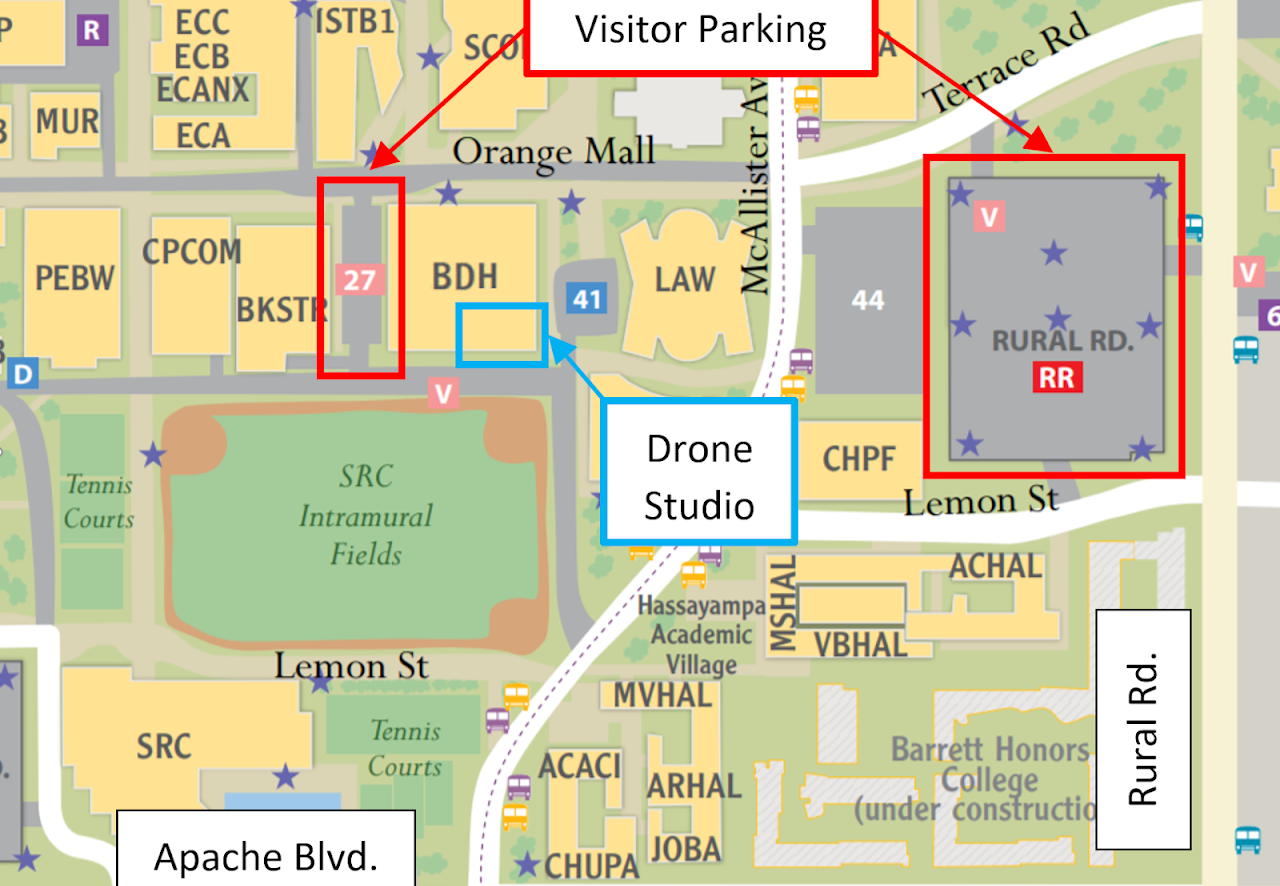ASU Drone Studio
Rules
Experiment Approval Required before use
- A description of experiments and the equipment involved must be approved by the ASU Drone Studio Staff and/or Fulton Schools Safety Office prior to use of the ASU Drone Studio.
- When operating drones or utilizing other potentially hazardous equipment, the ASU Drone Studio requires adherence to the ASU buddy system.
Buddy System Procedure
- When operating drones or utilizing other potentially hazardous equipment, the ASU Drone Studio requires adherence to the ASU buddy system.
- If you will be in the ASU Drone Studio, working directly with an identified hazard, you MUST have a buddy. If you will be in the ASU Drone Studio, but not working directly with an identified hazard, a buddy is recommended but not required.
- Determine who your buddy will be and notify them of: the building and room you will be in, the materials/equipment you will be working with, associated hazards and the time period during which you will be working.
- If the buddy is not required to be in the room with you, set up a communication schedule and check in with your buddy on pre-established, periodic basis (via phone call, text or email, etc.).
- Ensure the buddy has your contact information and the contact information for ASU Drone Studio Staff.
- Instruct your buddy to contact Public Safety immediately should a scheduled check-in be missed and you cannot be reached.
Tracked Space Usage
- Wear safety glasses when handling any powered robot/drone.
- Wear a face shield and gloves when handling a powered drone with a propeller.
- No one is allowed in the tracked space when operating any unmanned aerial vehicle (UAV).
- Test zone(s) must be unoccupied before initiating aerial vehicle activity.
- No alteration of the tracked space or control center is allowed.Any marking on the floor or walls must be temporary. DO NOT use tapes with strong adhesive. Use of Post-its or masking tape is recommended.
- All equipment used in experiments MUST be removed from BOTH the tracked space and control center by end of reservation.
- Follow Fulton Schools Office of Infrastructure and Safety guidance regarding the use of LiPo batteries.
- Do not leave ANY rechargeable batteries unattended while charging.
- THE COST OF REPAIR OR REPLACEMENT OF ANY PART OF THE SPACE OR EQUIPMENT CAUSED BY THE USERS OF THE ASU DRONE STUDIO WILL BE CHARGED TO THE PRIMARY INVESTIGATOR(S) OR RESERVING PARTY.
- FAILURE TO COMPLY WITH ANY OF THE RULES ABOVE OR RULES FOUND IN THE ASU DRONE STUDIO RULES AND REGULATIONS MAY RESULT IN REMOVAL OF RESERVATION PRIVILEGES.
Lithium polymer (LiPo) rechargeable batteries
Storage
- Don’t store near heat or ignition sources.
Don’t store near flammable or combustible materials. - Use a UL, FM or FAA listed/rated fire resistant LiPo safety bag, safety box or other listed/rated fire-resistant container.
- There are many LiPo safe bags and boxes on the market for short or long-term storage.
Charging
- Use the manufacturer’s original charger following manufacturers charging instructions.
- Keep it cool and in open air – don’t confine it as heat can build up.
- Use a UL, FM or FAA listed/rated fire resistant LiPo safety bag, safety box or other listed/rated fire-resistant container as recommended for charging and storing.
- Make sure that the charger has sensed the battery correctly.
- Don’t overcharge and don’t trickle charge.
- NEVER LEAVE ANY BATTERY TO CHARGE UNATTENDED.
Usage
- Follow manufacturer’s usage instructions.
- Complete the product registration process in case of product alerts or recalls.
- Also, monitor the news, industry trends, regulators Consumer Product Safety Commission (CPSC) and others for alerts and recalls.
- Don’t use them on conductive or combustible environments or surfaces.
- Keep all flammables, corrosives and combustibles away.
- Keep sharp objects away.
- Don’t reverse polarities.
- Avoid static electricity.
- Don’t mix battery types, new and old, etc.
If an potential safety issue arises
- Perform a hazard assessment (including failure modes).
- Keep an eye and ear on them during charging – don’t charge unattended.
- Use heat-protective gloves and safety glasses/goggles for any issues.
- Don’t refrigerate LiPo batteries (due to condensation shorting).
- Remove from charging (if safe).
- Don’t poke or disturb them.
- Investigate all incidents (including non-negative events).
- Contact other staff (lab manger cell phone: 480-310-3232), faculty, ASU Environmental Health and Safety, ASU Police Department and/or 9-1-1 as needed for help.
Fire extinguisher or fire blankets
As with any use of a fire extinguisher, only do so if you feel capable and can do so safely. Even though lithium is a combustible metal and would normally use a class D extinguisher, National Fire Protection Association so far has found using a regular dry chemical or powder extinguisher will often work. Letting it burn will likely cause more damage than using an extinguisher and produce toxic byproducts and the LiPo may even explode. If it isn’t safe, then evacuate and wait for the Fire Department.
Additional safety guidance
Contact Rita Bottesch, Fulton Schools Office of Infrastructure and Safety officer ([email protected]) for additional safety guidance.
ASU Drone Studio
611 E. Orange St.
Tempe, AZ 85281
Bulldog Hall (BDH) 143/145
MAP
Contact
Sponsors
Air Force Office of Scientific Research, Defense University Research Instrumentation Program (DURIP) award
Fulton Schools faculty contributions
Office of the Dean, Ira A. Fulton Schools of Engineering
ASU Drone Studio Committee
The ASU Drone Studio is managed by the Ira A. Fulton Schools of Engineering at ASU.
